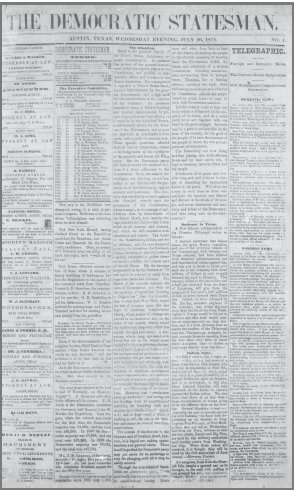Inside the Statesman’s very first edition
A box on the front page of the July 26, 1871 Democratic Statesman newspaper lists the sales rates, including $6 for year’s subscription.
To the left on the front page are “Business Cards,” an early, minimal version of advertisements for several attorneys, two medical doctors, two manufacturers, an auctioneer, a merchant and a photographer, William J. Oliphant, who is credited with publishing the first photographs of a buffalo hunt.
His home, the Oliphant-Walker House, still stands in Hyde Park.
E.R. Bracken’s Capitol Hotel on Congress Avenue — “Every exertion will be used to render guests comfortable” — advertised, as did C.W. Grooms’ saloon and billiard hall, also on Congress — “The best brands of Havana cigars, liquors, etc. of all kinds constantly kept on hand.”
In the far-right column, under the heading “Telegraphic,” one finds very short items about foreign and domestic news, a reminder that today’s newspaper term “wire story” originated in the earliest messages sent via telegraph wires. One can read about an insurgency in Cuba, a squelched rebellion in Jamaica and political wrangling between William Gladstone and Benjamin Disraeli in the House of Commons.
Also on the front page, one finds reports labeled “Indian News” — a military man predicted fresh warfare — and “Railroad to Texas.” In fact, Austin welcomed its first train — a different one — later that year on Dec. 25.
Much of the following three pages are taken up by more ads, brief local news and crime reports, including one headlined “Cold-Blooded Murder — $1,700 Taken by the Murderer — Parties Arrested on Suspicion.” It was the era of the great cattle drives from Texas to stockyards and rail centers north and northwest, and one notice announced “New Cattle Route — Good Water, Good Grass, No Settlement — Don’t Be Misled by Agents of Rival Lines.”
As was the custom back then, the editor published an unsigned poem, “The Syren,” and a longish short story, “A Magician Among the Indians,” an adventure yarn somewhat in the style of Mark Twain that also contains contemptuous portrayals of Native Americans.
This practice of offering poetry and short stories, often from unpaid contributors, continued at this newspaper at least until the 1970s.
The first four-page issue of the Democratic Statesman came out July 26, 1871. [Contributed by Newspapers.com]
